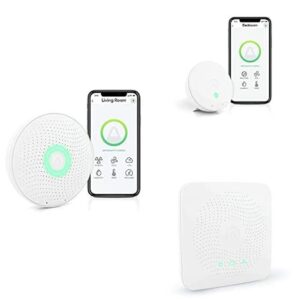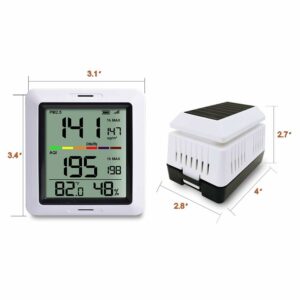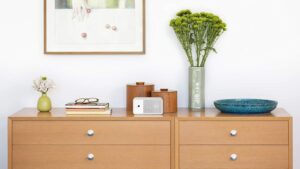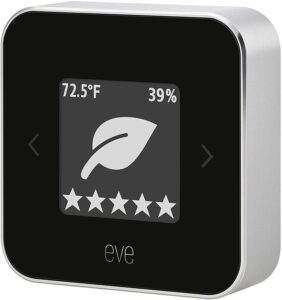Poor air quality can lead to health issues like colds, sinus problems, asthma, allergies, etc. This can be due to various reasons like smoking neighbors, pets, outdoor work, poor ventilation, etc. To improve air quality, air quality sensors are an effective solution. These sensors detect unpleasant odors, gases and particles in the air and provide a healthy living environment.
Air quality sensors come in two forms, indoor and outdoor, and both serve different purposes. Indoor air quality sensors are ideal for those who spend most of their time indoors, while outdoor air quality sensors are best for those who are often outside. With air quality sensors, you can stay aware of the air quality in your home, office, or car, and take the necessary steps to improve it. Whether it’s monitoring indoor or outdoor air quality, these sensors offer valuable information on the conditions of your specific environment.
[ The Best Air Conditioner Filters for Allergies ]
Table of Contents
A List of Top Best Air Quality Sensors For Your Home
AIRTHINGS WAVE PLUS

Airthings Wave Plus is an indoor air quality sensor that detects odors, gases, carbon monoxide, and particles. It uses multiple sensors to collect information.
The Wave Plus connects to your phone or tablet using the Airthings U Control app. The app lets you see all the data collected by your sensors. You can see current sensor readings, historical data, and the last known location. You can also filter the sensor data and see the air quality at a specific location. You can set up notifications of when the sensors have detected a change in the air quality. The Wave Plus connects to Google Home, Amazon Alexa, and Apple HomeKit. This lets you control your smart home with voice commands.
UHOO INDOOR AIR SENSOR

While you should talk to your doctor about indoor air quality, it is a good idea to monitor the air quality in your home with an air quality sensor for home. uHoo Indoor Air Sensor uses infrared sensing technology to detect gases, odors, and particles in the air.
The sensor connects to your phone or tablet via Bluetooth. The sensor collects data and uploads it to the uHoo app. The app lets you view data from your sensors, control the sensor settings, and set up notifications when the sensors have detected a change in the air quality.
The uHoo Indoor Air Sensor works with Amazon Alexa, Apple HomeKit, Google Assistant, Samsung SmartThings, Wink, and IFTTT. This lets you control your smart home with voice commands.
ECOWITT WH0290 AIR QUALITY MONITOR

ECOWITT WH0290 Air Quality Monitor uses ultraviolet LED technology to detect the presence of odors, gases, and particulate matter in the air. The sensor connects to your phone or tablet via Bluetooth. It collects data and uploads it to the ECOWITT app. The app lets you view data from your sensors, set up notifications of when the sensors have detected a change in the air quality, and control the sensor settings.
The ECOWITT WH0290 Air Quality Monitor works with Amazon Alexa, Apple HomeKit, Google Assistant, Samsung SmartThings, Wink, and IFTTT. This lets you control your smart home with voice commands.
AWAIR ELEMENT INDOOR AIR QUALITY MONITOR

Awair Element Indoor Air Quality Monitor uses infrared sensing technology to detect gases, odors, and particles in the air. It connects to your phone or tablet via Bluetooth. It collects data and uploads it to the Awair app. The app lets you view data from your sensors, control the sensor settings, and set up notifications when the sensors have detected a change in the air quality.
The Awair Element Indoor Air Quality Monitor works with Amazon Alexa, Apple HomeKit, Google Assistant, Samsung SmartThings, Wink, and IFTTT. This lets you control your smart home with voice commands.
EVE ROOM INDOOR AIR QUALITY MONITOR

Eve Room Indoor Air Quality Monitor uses infrared sensing technology to detect gases, odors, and particles in the air. It connects to your phone or tablet via Bluetooth. It collects data and uploads it to the Eve app. The app lets you view data from your sensors, set up notifications of when the sensors have detected a change in the air quality, and control the sensor settings.
The Eve Room Indoor Air Quality Monitor works with Amazon Alexa, Apple HomeKit, Google Assistant, Samsung SmartThings, Wink, and IFTTT. This lets you control your smart home with voice commands.
Some tips on how to improve air quality in your living room
1. Ventilate regularly
Open windows and doors to let fresh air in, especially on windy days. If you have a central air conditioning or heating system, make sure the filters are clean and in good condition.
2. Reduce dust and other pollutants
Dust and other pollutants can build up in your living room over time, so it’s important to clean regularly. Vacuum and dust regularly, and use a damp cloth to wipe down surfaces. If you have pets, vacuum and brush them regularly to help reduce dander.
3. Add plants
Plants can help improve air quality by absorbing pollutants and releasing oxygen. Choose plants that are known for their air-purifying properties, such as peace lilies, spider plants, and English ivy.
4. Use an air purifier
If you have allergies or asthma, an air purifier can help improve air quality in your living room. Air purifiers remove pollutants from the air, such as dust, pollen, pet dander, and mold spores.
5. Avoid smoking and cooking in your living room
Smoke and cooking fumes can contain harmful pollutants that can make it difficult to breathe. If you smoke, try to smoke outside, and if you cook, use a vent hood to help remove fumes from the air.
By following these tips, you can improve air quality in your living room and make it a healthier and more comfortable place to spend time.
Here are some additional tips:
Choose low-VOC (volatile organic compound) paints and finishes. VOCs can off-gas and contribute to poor indoor air quality.
Avoid using air fresheners, candles, and other scented products. These products can contain harmful chemicals that can irritate your respiratory system.
Keep your living room clean and organized. Clutter can trap dust and other pollutants.
Get regular professional cleanings. This will help remove any pollutants that may have built up over time.
